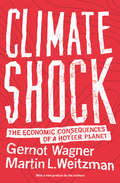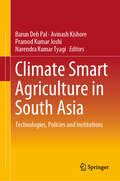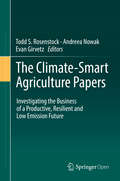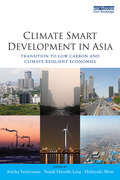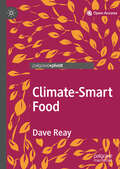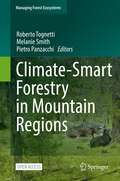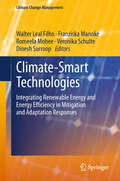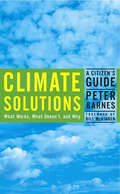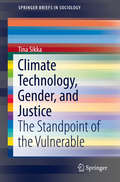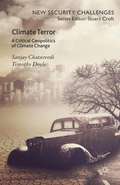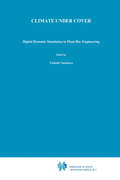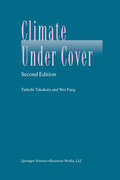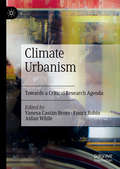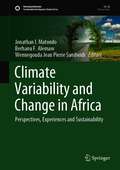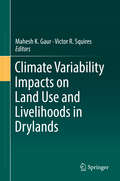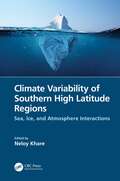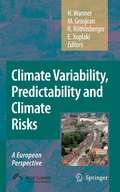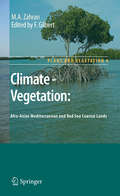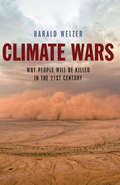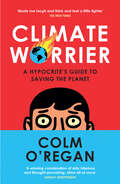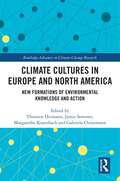- Table View
- List View
Climate Shock: The Economic Consequences of a Hotter Planet (PDF)
by Gernot Wagner Martin L. WeitzmanIf you had a 10 percent chance of having a fatal car accident, you'd take necessary precautions. If your finances had a 10 percent chance of suffering a severe loss, you'd reevaluate your assets. So if we know the world is warming and there's a 10 percent chance this might eventually lead to a catastrophe beyond anything we could imagine, why aren't we doing more about climate change right now? We insure our lives against an uncertain future--why not our planet?In Climate Shock, Gernot Wagner and Martin Weitzman explore in lively, clear terms the likely repercussions of a hotter planet, drawing on and expanding from work previously unavailable to general audiences. They show that the longer we wait to act, the more likely an extreme event will happen. A city might go underwater. A rogue nation might shoot particles into the Earth's atmosphere, geoengineering cooler temperatures. Zeroing in on the unknown extreme risks that may yet dwarf all else, the authors look at how economic forces that make sensible climate policies difficult to enact, make radical would-be fixes like geoengineering all the more probable. What we know about climate change is alarming enough. What we don't know about the extreme risks could be far more dangerous. Wagner and Weitzman help readers understand that we need to think about climate change in the same way that we think about insurance--as a risk management problem, only here on a global scale.With a new preface addressing recent developments Wagner and Weitzman demonstrate that climate change can and should be dealt with--and what could happen if we don't do so--tackling the defining environmental and public policy issue of our time.
Climate Smart Agriculture in South Asia: Technologies, Policies and Institutions
by Barun Deb Pal Avinash Kishore Pramod Kumar Joshi Narendra Kumar TyagiThis book discusses various climate smart agro-technologies, their technical and economic feasibility across heterogeneous agro-climatic conditions, assessing farmers’ willingness to adopt those technologies, impact of climate smart technology in agricultural production and possible policy and investment opportunities to upscale it. Containing eight chapters, the book starts with a discussion about the methodological aspects of priority setting of the farm technologies across various regions of South Asia including Eastern Indo-Gangetic plain, Western Indo-Gangetic Plain and arid regions. Using data from field based trials and expert solicitations, the book next deliberates on a list of feasible technologies, assessed by constructing climate smart Feasibility Index. Further on, there is an analysis, using stated preference method, of the behaviour of farmers in adopting climate smart technologies. Preference of women farmers has been given a special focus in this book. After discussing the method priority setting of the farm technologies, impact of climate smart technologies has been analysed using real time data. Government policies have been reviewed with the view of achieving climate smart agriculture in South Asia. The book also describes the optimization modelling framework for investment allocation and technology prioritization. The model integrates both the bio-physical and the economic optimization model to capture the agro-climatic heterogeneity within the region and the variability of technical feasibility across regions and crops. Results of this model will help policy makers to identify how much to invest, where to invest and what technologies to prioritize for investments.
The Climate-Smart Agriculture Papers: Investigating The Business Of A Productive, Resilient And Low Emission Future
by Todd S. Rosenstock Andreea Nowak Evan GirvetzThis book is open access under a CC BY 4.0 license.This volume shares new data relating to Climate-Smart Agriculture (CSA), with emphasis on experiences in Eastern and Southern Africa. The book is a collection of research by authors from over 30 institutions, spanning the public and private sectors, with specific knowledge on agricultural development in the region discussed. The material is assembled to answer key questions on the following five topic areas: (1) Climate impacts: What are the most significant current and near future climate risks undermining smallholder livelihoods? (2) Varieties: How can climate-smart varieties be delivered quickly and cost-effectively to smallholders? (3) Farm management: What are key lessons on the contributions from soil and water management to climate risk reduction and how should interventions be prioritized? (4) Value chains: How can climate risks to supply and value chains be reduced? and (5) Scaling up: How can most promising climate risks reduction strategies be quickly scaled up and what are critical success factors? Readers who will be interested in this book include students, policy makers, and researchers studying climate change impacts on agriculture and agricultural sustainability.
Climate Smart Development in Asia: Transition to Low Carbon and Climate Resilient Economies
by Ancha Srinivasan Frank Hiroshi Ling Hideyuki MoriThe future of China, India and Asia’s other emerging economies and their ability to take a ‘low-carbon’ and ‘climate-resilient’ development path determine the future of global carbon emissions and climate change. Indeed, the battle to confront global climate change will be won or lost in Asia. The transition to a low-carbon, climate-resilient economy (LCE), which involves many steps towards improved energy efficiency, alternative energy sources and transport systems, sustainable land use, eco-friendly consumption and proactive adaptation, may be regarded as the world's fourth revolution, after the industrial revolution, agricultural revolution, and the information revolution. Asia is highly vulnerable to impacts of climate change. Yet because of its dynamic economies and massive populations, Asia offers the greatest opportunity for overcoming the trade-offs and pursuing low-carbon development pathways. With a growing consensus that there is limited time to avoid the worst impacts of climate change, scientists, engineers, policymakers, and economists across Asia have recently begun discussions on how Asia can make a transition to LCE. Most discussions, however, focused on transfer of technologies from developed to developing countries and overlooked other equally important challenges such as financing, governance, and information dissemination. This book is the first to look at these neglected aspects of LCE and attempt to integrate both market-based and technology-based solutions into a comprehensive strategy to creating a roadmap for LCE in Asia. This book is an essential reading for economists, policy makers, practitioners, engineers and researchers concerned with climate change, energy production and development in Asia and the impacts and potential for the world.
Climate Smart Development in Asia: Transition to Low Carbon and Climate Resilient Economies
by Ancha Srinivasan Frank Hiroshi Ling Hideyuki MoriThe future of China, India and Asia’s other emerging economies and their ability to take a ‘low-carbon’ and ‘climate-resilient’ development path determine the future of global carbon emissions and climate change. Indeed, the battle to confront global climate change will be won or lost in Asia. The transition to a low-carbon, climate-resilient economy (LCE), which involves many steps towards improved energy efficiency, alternative energy sources and transport systems, sustainable land use, eco-friendly consumption and proactive adaptation, may be regarded as the world's fourth revolution, after the industrial revolution, agricultural revolution, and the information revolution. Asia is highly vulnerable to impacts of climate change. Yet because of its dynamic economies and massive populations, Asia offers the greatest opportunity for overcoming the trade-offs and pursuing low-carbon development pathways. With a growing consensus that there is limited time to avoid the worst impacts of climate change, scientists, engineers, policymakers, and economists across Asia have recently begun discussions on how Asia can make a transition to LCE. Most discussions, however, focused on transfer of technologies from developed to developing countries and overlooked other equally important challenges such as financing, governance, and information dissemination. This book is the first to look at these neglected aspects of LCE and attempt to integrate both market-based and technology-based solutions into a comprehensive strategy to creating a roadmap for LCE in Asia. This book is an essential reading for economists, policy makers, practitioners, engineers and researchers concerned with climate change, energy production and development in Asia and the impacts and potential for the world.
Climate-Smart Food
by Dave ReayThis open access book asks just how climate-smart our food really is. It follows an average day's worth of food and drink to see where it comes from, how far it travels, and the carbon price we all pay for it. From our breakfast tea and toast, through breaktime chocolate bar, to take-away supper, Dave Reay explores the weather extremes the world’s farmers are already dealing with, and what new threats climate change will bring. Readers will encounter heat waves and hurricanes, wildfires and deadly toxins, as well as some truly climate-smart solutions. In every case there are responses that could cut emissions while boosting resilience and livelihoods. Ultimately we are all in this together, our decisions on what food we buy and how we consume it send life-changing ripples right through the global web that is our food supply. As we face a future of 10 billion mouths to feed in a rapidly changing climate, it’s time to get to know our farmers and herders, our vintners and fisherfolk, a whole lot better.
Climate-Smart Forestry in Mountain Regions (Managing Forest Ecosystems #40)
by Roberto Tognetti Melanie Smith Pietro PanzacchiThis open access book offers a cross-sectoral reference for both managers and scientists interested in climate-smart forestry, focusing on mountain regions. It provides a comprehensive analysis on forest issues, facilitating the implementation of climate objectives. This book includes structured summaries of each chapter.Funded by the EU’s Horizon 2020 programme, CLIMO has brought together scientists and experts in continental and regional focus assessments through a cross-sectoral approach, facilitating the implementation of climate objectives. CLIMO has provided scientific analysis on issues including criteria and indicators, growth dynamics, management prescriptions, long-term perspectives, monitoring technologies, economic impacts, and governance tools.
Climate-Smart Technologies: Integrating Renewable Energy and Energy Efficiency in Mitigation and Adaptation Responses (Climate Change Management)
by Walter Leal Filho, Franziska Mannke, Romeela Mohee, Veronika Schulte and Dinesh SurroopThe book addresses the perceived need for a publication with looks at both, climate smart technologies and the integration of renewable energy and energy efficiency in mitigation and adaptation responses. Based on a set of papers submitted as part of the fifth on-line climate conference (CLIMATE 2012) and a major conference on renewable energy on island States held in Mauritius in 2012, the book provides a wealth of information on climate change strategies and the role of smart technologies. The book has been produced in the context of the project "Small Developing Island Renewable Energy Knowledge and Technology Transfer Network" (DIREKT), funded by the ACP Science and Technology Programme, an EU programme for cooperation between the European Union and the ACP region.
Climate Solutions: A Citizen's Guide
by Peter Barnes Bill McKibbenMillions of Americans are demanding that all levels of government—local, state, and federal—take immediate and effective action to fight climate change. But there’s a big problem. Hundreds of policy ideas are floating about, and many of them aren’t very good. It’s quite possible that bad climate policy will result, and that many years will then be lost before real emission reductions occur. We can’t afford to let that happen. That’s why this citizen’s guide is so important. It explains in clear and simple language what different climate policies will do—and what they won’t do. It tells you who’s behind the policies, who’d pay for them, and who’d profit. It strips away the spin and tells you the key facts you need to know. In a very real sense, this guide ushers in the next stage of the global-warming debate. In the first stage, we discussed the problem. In the next stage, we must choose solutions. Should we adopt a carbon tax? A carbon cap? A trading system that allows companies to “offset” their emissions by paying others to plant trees? This guide examines these proposals and many others. It’s essential reading for anyone who wants to stop climate change before it’s too late.
Climate Technology, Gender, and Justice: The Standpoint Of The Vulnerable (Springerbriefs In Sociology Ser.)
by Tina SikkaThis book is the first to undertake a gendered analysis of geoengineering and alternative energy sources. Are either of these technologies sufficiently attendant to gender issues? Do they incorporate feminist values as articulated by the renowned social philosopher Helen Longino, such as empirical adequacy, novelty, heterogeneity, complexity and applicability to human needs? The overarching argument in this book contends that, while mitigation strategies like solar and wind energy go much further to meet feminist objectives and virtues, geoengineering is not consistent with the values of justice as articulated in Longino's feminist approach to science. This book provides a novel, feminist argument in support of pursuing alternative energy in the place of geoengineering. It provides an invaluable contribution for academics and students working in the areas of gender, science and climate change as well as policy makers interested in innovative ways of taking up climate change mitigation and gender.
Climate Terror: A Critical Geopolitics of Climate Change (New Security Challenges)
by Timothy Doyle Sanjay ChaturvediClimate Terror engages with a highly differentiated geographical politics of global warming. It explores how fear-inducing climate change discourses could result in new forms of dependencies, domination and militarised 'climate security'.
Climate Under Cover: Digital Dynamic Simulation in Plant Bio-Engineering
by Tadashi TakakuraFrom mulching to greenhouses, the air space between the cover and the soil surface is the key to the classification of climates under cover. The same mechanism governs environments produced by the various covers. This book describes and analyses all the different environments from mulching to greenhouses. The relationship between plants and environment is another important topic in the book. Stress is placed on the link between quantitative phenomena and qualitative analyses. Most phenomena involved are nonlinear and non-steady-state. An approach called System Dynamics is used, and simulation models developed in the simulation language CSMP are fully used. The subjects covered are of relevance to graduate students, to scientists and researchers in agriculture and biological sciences and, of course, to agricultural organizations in both the developing and developed countries.
Climate Under Cover
by Tadashi Takakura Wei Fang1.1. INTRODUCTION Plastic covering, either framed or floating, is now used worldwide to protect crops from unfavorable growing conditions, such as severe weather and insects and birds. Protected cultivation in the broad sense, including mulching, has been widely spread by the innovation of plastic films. Paper, straw, and glass were the main materials used before the era of plastics. Utilization of plastics in agriculture started in the developed countries and is now spreading to the developing countries. Early utilization of plastic was in cold regions, and plastic was mainly used for protection from the cold. Now plastic is used also for protection from wind, insects and diseases. The use of covering techniques started with a simple system such as mulching, then row covers and small tunnels were developed, and finally plastic houses. Floating mulch was an exception to this sequence: it was introduced rather recently, although it is a simple structure. New development of functional and inexpensive films triggered widespread use of floating mulch. Table 1.1. The use a/plastic mulch in the world (after Jouet, 2001).
Climate Urbanism: Towards a Critical Research Agenda
by Vanesa Castán Broto Enora Robin Aidan WhileThis book argues that the relationship between cities and climate change is entering a new and more urgent phase. Thirteen contributions from a range of leading scholars explore the need to rethink and reorient urban life in response to climatic change. Split into four parts it begins by asking ‘What is climate urbanism?’ and exploring key features from different locations and epistemological traditions. The second section examines the transformative potential of climate urbanism to challenge social and environmental injustices within and between cities. In the third part authors interrogate current knowledge paradigms underpinning climate and urban science and how they shape contemporary urban trajectories. The final section focuses on the future, envisaging climate urbanism as a new communal project, and focuses on the role of citizens and non-state actors in driving transformative action. Consolidating debates on climate urbanism, the book highlights the opportunities and tensions of urban environmental policy, providing a framework for researchers and practitioners to respond to the urban challenges of a radically climate-changed world.
Climate Variability and Change in Africa: Perspectives, Experiences and Sustainability (Sustainable Development Goals Series)
by Jonathan I. Matondo Berhanu F. Alemaw Wennegouda Jean Pierre SandwidiThis book presents a comprehensive overview of climate variability and change in Africa, and includes impact assessments and case studies from integration frameworks, with a particular focus on climate, agriculture and water resources. Richly illustrated, the book highlights case studies from western, eastern and southern African region, and explores related development policies. Climate change adaptation research, prediction, and reanalysis are also addressed
Climate Variability Impacts on Land Use and Livelihoods in Drylands
by Mahesh K. Gaur Victor R. SquiresThis edited volume is devoted to the examination of the implications of the inevitable changes wrought by global change on the welfare and livelihoods of tens of millions of people who live in dryland regions. Global change is more than just climate change and the ramifications of changing trade patterns (geopolitical and economic aspects), the shift to the market economy, demographic factors (population growth, urbanization and re-settlement), receive attention here. Land use change specialists, policy makers and natural resource management agencies will find the book very useful.Chapters focus on examples that are drawn from a number of sources including previously unpublished studies on the impact of climate change, markets and economics on pastoralist and dryland farming households. The key focus is to provide readers with insights into the real world implications of change (including an analysis of the drivers of change) on these vulnerable groups within dryland societies. The role of humans as agents of these changes is canvassed. A regional analysis of the world's drylands is also performed including those in Australia, Argentina, India, North America, China, North Africa, Central Asia and Southern Africa.
Climate Variability of Southern High Latitude Regions: Sea, Ice, and Atmosphere Interactions
by Neloy KhareThis is the first book to provide a comprehensive overview of climate change–related investigations carried out by Indian researchers through initiatives in southern high latitude regions. It explains climate variability over the Southern Ocean and Antarctica; air, sea, ice, and atmosphere interactions; and the impact of climate variability on sea ice and the polar atmosphere. The data were gathered at two Indian research bases, Maitri and Bharti, which are ideal sites to study and understand climatic evolution in Antarctic in the past and recent changes. This book helps to understand climatological perspectives and to evaluate some of the most pressing issues in the south polar region. FEATURES Highlights the achievements of India in the contemporary field of Antarctic climatology Presents four decades of research by Indian scientists in Antarctica, which is now shared for the first time with the global community Includes case studies on climatological and environmental conditions of natural archives to shed light on climate scenarios in the Southern Ocean and Antarctic regions Covers various aspects of climate variability and induced air-sea-ice-atmosphere interactions This book is edited by one of the top scientists and researchers of India in the field of paleoclimatology, and the contributors are experts in the Antarctic region.
Climate Variability of Southern High Latitude Regions: Sea, Ice, and Atmosphere Interactions
by Neloy KhareThis is the first book to provide a comprehensive overview of climate change–related investigations carried out by Indian researchers through initiatives in southern high latitude regions. It explains climate variability over the Southern Ocean and Antarctica; air, sea, ice, and atmosphere interactions; and the impact of climate variability on sea ice and the polar atmosphere. The data were gathered at two Indian research bases, Maitri and Bharti, which are ideal sites to study and understand climatic evolution in Antarctic in the past and recent changes. This book helps to understand climatological perspectives and to evaluate some of the most pressing issues in the south polar region. FEATURES Highlights the achievements of India in the contemporary field of Antarctic climatology Presents four decades of research by Indian scientists in Antarctica, which is now shared for the first time with the global community Includes case studies on climatological and environmental conditions of natural archives to shed light on climate scenarios in the Southern Ocean and Antarctic regions Covers various aspects of climate variability and induced air-sea-ice-atmosphere interactions This book is edited by one of the top scientists and researchers of India in the field of paleoclimatology, and the contributors are experts in the Antarctic region.
Climate Variability, Predictability and Climate Risks: A European Perspective
by Heinz Wanner Martin Grosjean Regine Röthlisberger Elena XoplakiThis book provides an integrated assessment of issues related to climate variability and change, predictability and risks. It details both the technical aspects of variability and abrupt climate change and the agricultural and economical impacts and consequences.
Climate - Vegetation: Afro-Asian Mediterranean and Red Sea Coastal Lands (Plant and Vegetation #4)
by M.A. ZahranDeserts are unique ecosystems with their own biotic and abiotic components, and are often rich in renewable natural resources, the appropriate management of which can contribute significantly to the sustainable management of desert regions for the welfare of the people. Yet while there are many books on the flora of the countries fringing the important desert countries of the Mediterranean and Red Seas, there or few books reporting on their ecophysiology and vegetation ecology. This book presents the vegetation types of the African and Asian countries of the Mediterranean and Red Sea coastal regions, and discusses the ecological threats and economic applications of these critical resources. In particular, it examines the relationships between climate and vegetation, and discusses these within the context of desertification, agro-industrial applications, ecotourism and sustainable development. The book will provide a valuable reference for researchers and graduate students involved in plant ecology, biogeography, economic botany and environmental management in the Afro-Asian Mediterranean and Red Sea coastal regions, as well as other desert regions around the world.
Climate Wars: What People Will Be Killed For in the 21st Century
by Harald WelzerStruggles over drinking water, new outbreaks of mass violence, ethnic cleansing, civil wars in the earth's poorest countries, endless flows of refugees: these are the new conflicts and forces shaping the world of the 21st century. They no longer hinge on ideological rivalries between great powers but rather on issues of class, religion and resources. The genocides of the last century have taught us how quickly social problems can spill over into radical and deadly solutions. Rich countries are already developing strategies to garner resources and keep 'climate refugees' at bay. In this major book Harald Welzer shows how climate change and violence go hand in hand. Climate change has far-reaching consequences for the living conditions of peoples around the world: inhabitable spaces shrink, scarce resources become scarcer, injustices grow deeper, not only between North and South but also between generations, storing up material for new social tensions and giving rise to violent conflicts, civil wars and massive refugee flows. Climate change poses major new challenges in terms of security, responsibility and justice, but as Welzer makes disturbingly clear, very little is being done to confront them. The paperback edition includes a new Preface that brings the book up to date and addresses the most recent developments and trends.
Climate Wars: What People Will Be Killed For in the 21st Century
by Harald WelzerStruggles over drinking water, new outbreaks of mass violence, ethnic cleansing, civil wars in the earth's poorest countries, endless flows of refugees: these are the new conflicts and forces shaping the world of the 21st century. They no longer hinge on ideological rivalries between great powers but rather on issues of class, religion and resources. The genocides of the last century have taught us how quickly social problems can spill over into radical and deadly solutions. Rich countries are already developing strategies to garner resources and keep 'climate refugees' at bay. In this major book Harald Welzer shows how climate change and violence go hand in hand. Climate change has far-reaching consequences for the living conditions of peoples around the world: inhabitable spaces shrink, scarce resources become scarcer, injustices grow deeper, not only between North and South but also between generations, storing up material for new social tensions and giving rise to violent conflicts, civil wars and massive refugee flows. Climate change poses major new challenges in terms of security, responsibility and justice, but as Welzer makes disturbingly clear, very little is being done to confront them. The paperback edition includes a new Preface that brings the book up to date and addresses the most recent developments and trends.
Climate Worrier: A Hypocrite’s Guide to Saving the Planet
by Colm O’ReganBestselling author Colm O’Regan is a worrier. A professional one. Caution is his watchword. Risk aversion is his love language. Now Colm is grappling with the biggest worry of all: the whole ‘planet being on fire’ thing and how exactly we can help.
Climate Cultures in Europe and North America: New Formations of Environmental Knowledge and Action (Routledge Advances in Climate Change Research)
by Thorsten HeimannBringing together scholarly research by climate experts working in different locations and social science disciplines, this book offers insights into how climate change is socially and culturally constructed. Whereas existing studies of climate cultural differences are predominantly rooted in a static understanding of culture, cultural globalization theory suggests that new formations emerge dynamically at different social and spatial scales. This volume gathers analyses of climate cultural formations within various spaces and regions in the United States and the European Union. It focuses particularly on the emergence of new social movements and coalitions devoted to fighting climate change on both sides of the Atlantic. Overall, Climate Cultures in Europe and North America provides empirical and theoretical findings that contribute to current debates on globalization, conflict and governance, as well as cultural and social change. This book will be of great interest to students and scholars of climate change, environmental policy and politics, environmental sociology, and cultural studies.
Climate Cultures in Europe and North America: New Formations of Environmental Knowledge and Action (Routledge Advances in Climate Change Research)
by Thorsten Heimann Jamie Sommer Margarethe Kusenbach Gabriela ChristmannBringing together scholarly research by climate experts working in different locations and social science disciplines, this book offers insights into how climate change is socially and culturally constructed. Whereas existing studies of climate cultural differences are predominantly rooted in a static understanding of culture, cultural globalization theory suggests that new formations emerge dynamically at different social and spatial scales. This volume gathers analyses of climate cultural formations within various spaces and regions in the United States and the European Union. It focuses particularly on the emergence of new social movements and coalitions devoted to fighting climate change on both sides of the Atlantic. Overall, Climate Cultures in Europe and North America provides empirical and theoretical findings that contribute to current debates on globalization, conflict and governance, as well as cultural and social change. This book will be of great interest to students and scholars of climate change, environmental policy and politics, environmental sociology, and cultural studies.
